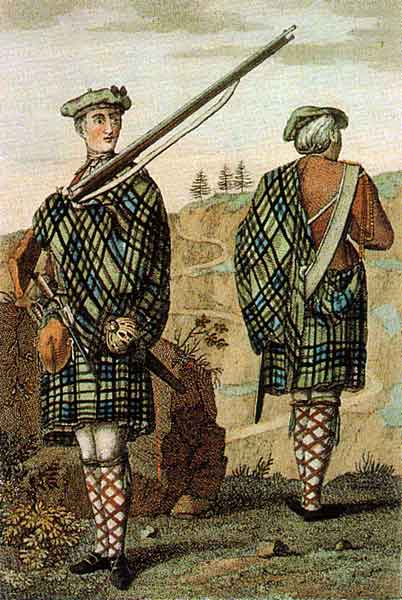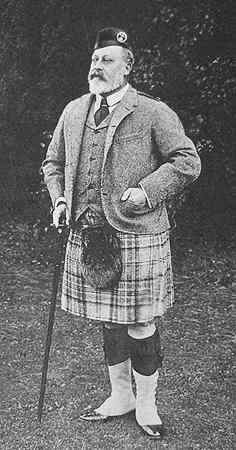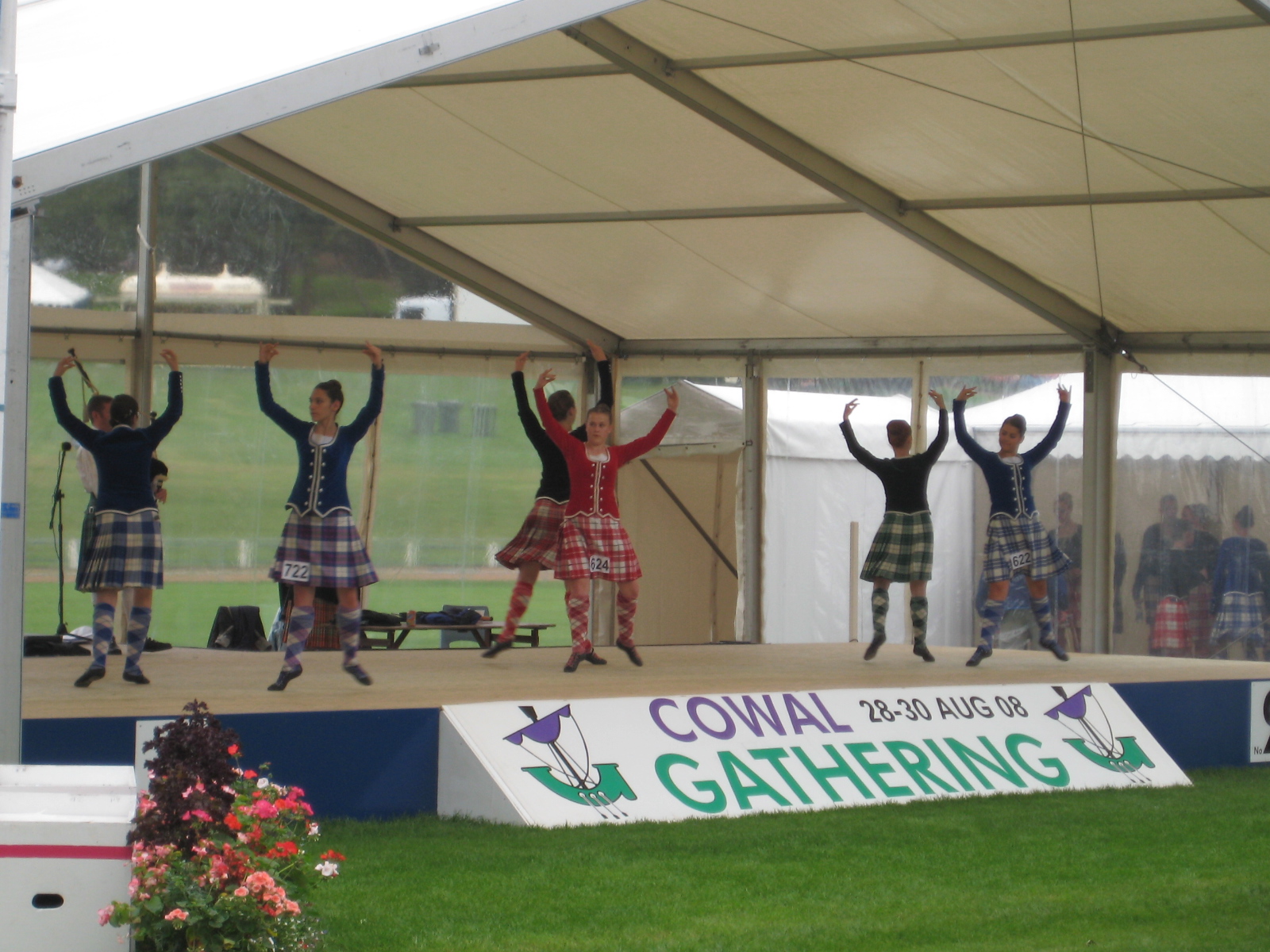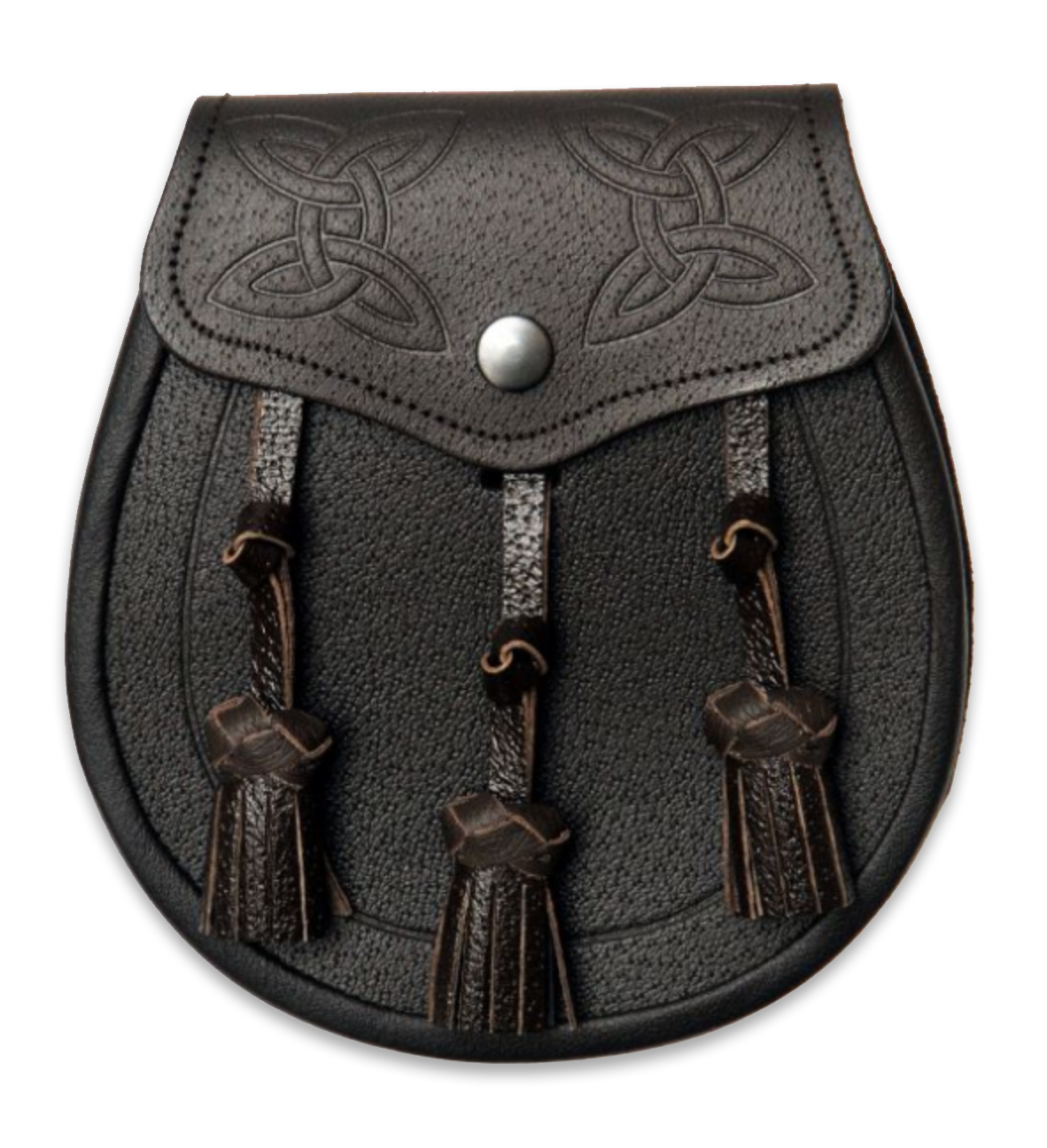|
Kilt
A kilt ( ) is a garment resembling a wrap-around knee-length skirt, made of twill-woven worsted wool with heavy pleats at the sides and back and traditionally a tartan pattern. Originating in the Scottish Highland dress for men, it is first recorded in the 16th century as the great kilt, a full-length garment whose upper half could be worn as a cloak. The small kilt or ''modern kilt'' emerged in the 18th century, and is essentially the bottom half of the great kilt. Since the 19th century, it has become associated with the wider culture of Scotland, and more broadly with Gaelic or Celtic heritage. Although the kilt is most often worn by men on formal occasions and at Highland games and other sporting events, it has also been adapted as an item of informal male clothing, returning to its roots as an everyday garment. Kilts are now made for casual wear in a variety of materials. Alternative fastenings may be used and pockets inserted to avoid the need for a sporran. Kilts ... [...More Info...] [...Related Items...] OR: [Wikipedia] [Google] [Baidu] |
History Of The Kilt
The history of the modern kilt stretches back to at least the end of the 16th century. The kilt first appeared as the belted plaid or great kilt, a full-length garment whose upper half could be worn as a cloak draped over the shoulder, or brought up over the head as a hood. The small kilt or walking kilt (similar to the modern or military kilt) did not develop until the late 17th or early 18th century, and is essentially the bottom half of the great kilt. The noun ''kilt'' comes from the Scots language, Scots verb ''kilt'' meaning 'to tuck up the clothes around the body'. The Scots word derives from the Old Norse ''kjalta'' (meaning 'lap', 'fold of a gathered skirt'). The great kilt The belted plaid () or great plaid (), also known as the great kilt, is likely to have evolved over the course of the 16th century from the earlier "brat" or woollen cloak (also known as a plaid) which was worn over a tunic (the ), which was also worn by the Gaels, Gaelic Irish. This earlier cloak ... [...More Info...] [...Related Items...] OR: [Wikipedia] [Google] [Baidu] |
Tartan
Tartan or plaid ( ) is a patterned cloth consisting of crossing horizontal and vertical bands in multiple colours, forming repeating symmetrical patterns known as ''setts''. Originating in woven wool, tartan is most strongly associated with Scotland, where it has been used for centuries in traditional clothing such as the kilt. Historically, specific tartans were linked to Scottish clans, families, or regions, with patterns and colours derived from local dyes. The earliest surviving samples of tartan-style cloth are around 3,000 years old and were discovered in Xinjiang, China. Tartan became a symbol of Scottish identity, especially from the 16th century onward, despite bans following the Jacobite rising of 1745 under the Dress Act 1746. The 19th-century Highland Revival popularized tartan globally, associating it with Highland dress and the Scottish diaspora. Today, tartan is used worldwide in clothing, accessories, and design, transcending its traditional roots. M ... [...More Info...] [...Related Items...] OR: [Wikipedia] [Google] [Baidu] |
True Scotsman
"True Scotsman" is a humorous term used in Scotland for a man wearing a kilt without undergarments. Though the tradition originated in the military, it has entered Scottish lore as a rite, an expression of light-hearted curiosity about the custom, and even as a subversive gesture. However, the notion that no undergarments is the "true" or culturally authentic way to wear a kilt is a myth, as there were and still are many circumstances were it would not be appropriate. These include situations where physical activity or high winds might cause exposure to onlookers, very cold temperatures, and during seasons where swarms of biting flies are present. History The earliest forms of the kilt, called a plaid or "great kilt" (feileadh mòr), were worn over the existing garments of the time, such as trews or breeches with hose or leg wraps. From the late 1600s onward, historical paintings start to show some kilts worn with high socks, with no covering on the visible part of the uppe ... [...More Info...] [...Related Items...] OR: [Wikipedia] [Google] [Baidu] |
Kilt Pin
The kilt pin is a piece of jewellery that is usually worn on the lower corner of the outer apron of a kilt. Its function is to prevent the apron falling or blowing open, by adding weight to the outer apron, and it is commonly seen as a form of decoration.Stubborn Stag , The purpose of a kilt pin. It does not pin the outer apron to the inner fabric, which is a common misconception. It is common for kilt pins to be decorative, with many featuring symbols, national emblems, or native animals and plants. Contemporary kilt pins often symbolise personal interests, favourite places or they are personalised for the wearer. [...More Info...] [...Related Items...] OR: [Wikipedia] [Google] [Baidu] |
Highland Dress
Highland dress is the traditional, regional dress of the Highlands and Isles of Scotland. It is often characterised by tartan (''plaid'' in North America). Specific designs of shirt, jacket, bodice and headwear may also be worn. On rare occasions with clan badges and other devices indicating family and heritage. Men's Highland dress typically includes a kilt or trews. Although this may consist of clan tartan, it is more usual for tartans to be chosen for aesthetic reasons. A tartan full plaid, fly plaid, or short belted plaid may also be worn but usually only at very formal events or by the groom at a wedding. There are a number of accessories, which may include but are not limited to: a belt, sporran, sgian-dubh, knee-socks with a cuff known as kilt hose, garters, kilt pins and clan badges. Women's Highland dress is also based on the clan tartan, either that of her birth clan or, if married, that of her spouse's clan if she so chooses. Traditionally, women and girls ... [...More Info...] [...Related Items...] OR: [Wikipedia] [Google] [Baidu] |
Thomas Rawlinson (industrialist)
Thomas Rawlinson was an 18th-century English industrialist who some sources have claimed was the inventor of the modern kilt. He was the managing partner in the Invergarry ironworks and rebuilt Invergarry Castle which had been burned down by Col. Clayton following the Jacobite rebellion. Born in 1669, Thomas Rawlinson was the son of Thomas Rawlinson of Greythwaite. The family were Quaker ironmasters, his father and brother being partners in the Backbarrow Company which successfully developed charcoal blast furnaces at Backbarrow and Leighton. He died in 1737 shortly after the closure of Invergarry furnace Invergarry Furnace An agreement was signed on 23 March 1727 to lease John MacDonell's woodland for 31 years. Thomas Rawlinson was to be managing partner with a salary of £100 a year. His eight partners included his father and brother as well as other members of the Backbarrow Company but Thomas was said to have no previous experience of the industry. Iron lintels were ... [...More Info...] [...Related Items...] OR: [Wikipedia] [Google] [Baidu] |
Scottish Highland Dance
Highland dance or Highland dancing () is a style of competitive dancing developed in the Scottish Highlands in the 19th and 20th centuries, in the context of competitions at public events such as the Highland games. It was created from the Gaelic folk dance repertoire, but formalised with the conventions of ballet, and has been subject to influences from outside the Highlands. Highland dancing is often performed with the accompaniment of Highland bagpipe music, and dancers wear specialised shoes called ghillies or pumps. It is now seen at nearly every modern-day Highland games event. Highland dance should not be confused with Scottish country dance, cèilidh dancing, or clog dancing, although they too may be performed at Highland games and like competitions. Basic description of Highland dancing Highland dancing is a competitive and technical dance form requiring technique, stamina, and strength, and is recognised as a sport by the Sport Council of Scotland. In Highland ... [...More Info...] [...Related Items...] OR: [Wikipedia] [Google] [Baidu] |
Aboyne Dress
Aboyne dress is the name given to the prescribed attire for female dancers in the Scottish national dances, such as the Flora MacDonald's fancy, the Scottish lilt, and others. Male dancers wear the kilt for these dances, the kilt being a predominantly male garment. There are two versions of Aboyne Dress in use. Some consider the Aboyne as quite suited to the graceful movements of the national dances. The Aboyne Highland Games, established in 1867, have stipulated this style of attire for female dancers since 1952 for both National and Highland dances. Description A typical Aboyne dress consists of a dark bodice or elaborate waistcoat, decorative blouse, full tartan skirt and sometimes a petticoat and apron. Some have a tartan sash (usually draped over the shoulder and coming down towards the hem of the skirt in the back) rather than an apron. While appearing to be simple and plain, a properly made, modern Aboyne dress might and can be quite expensive. In one version, a t ... [...More Info...] [...Related Items...] OR: [Wikipedia] [Google] [Baidu] |
Sporran
The sporran (; Scottish Gaelic for ' purse'), a traditional part of male Scottish Highland dress, is a pouch that functions as a pocket for the kilt. Made of leather or fur, the ornamentation of the sporran is chosen to complement the formality of dress worn with it. The sporran is worn on a leather strap or chain, conventionally positioned in front of the groin of the wearer. Since the traditional kilt does not have pockets, the sporran serves as a wallet and container for any other necessary personal items. It is essentially a remnant of the common European medieval belt-pouch, superseded elsewhere as clothing came to have pockets, but continuing in the Scottish Highlands because of the lack of these accessories in traditional dress. The sporran hangs below the belt buckle; and much effort is made to match their style and design. The kilt belt buckle may be very ornate, and contain similar motifs to the sporran cantle and the sgian dubh. Early sporrans would have been worn su ... [...More Info...] [...Related Items...] OR: [Wikipedia] [Google] [Baidu] |
Belted Plaid
The belted plaid is a large blanket-like piece of fabric which is wrapped around the body with the material pleated or, more accurately, loosely gathered and secured at the waist by means of a belt. Typically, a portion of the belted plaid hangs down to about the knees (for men) or ankles (for women) with the rest of the material being wrapped up around the upper body in a variety of ways and pinned or otherwise secured to keep it in place. The belted plaid was a standard item of men's Highland dress from the late 16th century until the middle of the 18th century. It was also the precursor of the modern tailored kilt. Terminology The word in Gaelic roughly means blanket, and that was the original term for the garment. The belted plaid has been and is often referred to by a variety of different terms, including , ; and ''great kilt''; however, the garment was not known by the name ''great kilt'' during the years when it was in common use. Both the terms and are Gaelic terms, ... [...More Info...] [...Related Items...] OR: [Wikipedia] [Google] [Baidu] |
Going Commando
Underwear, underclothing, or undergarments are items of clothing worn beneath outer clothes, usually in direct contact with the skin, although they may comprise more than a single layer. They serve to keep outer clothing from being soiled or damaged by bodily excretions, to lessen the friction of outerwear against the skin, to shape the body, and to provide concealment or support for parts of it. In cold weather, long underwear is sometimes worn to provide additional warmth. Special types of undergarments have religious significance. Some items of clothing are designed as undergarments, while others, such as T-shirts and certain types of shorts, are appropriate both as underwear and outerwear. If made of suitable material or textile, some underwear can serve as nightwear or swimwear, and some undergarments are intended for sexual attraction or visual appeal. Undergarments are generally of two types, those that are worn to cover the torso and those that are worn to cover th ... [...More Info...] [...Related Items...] OR: [Wikipedia] [Google] [Baidu] |
Gaels
The Gaels ( ; ; ; ) are an Insular Celts, Insular Celtic ethnolinguistic group native to Ireland, Scotland, and the Isle of Man. They are associated with the Goidelic languages, Gaelic languages: a branch of the Celtic languages comprising Irish language, Irish, Manx language, Manx, and Scottish Gaelic. Gaelic language and culture originated in Gaelic Ireland, Ireland, extending to Dál Riata in western Scotland in the Middle Ages, Scotland. In antiquity, the Gaels Hiberno-Roman relations, traded with the Roman Empire and also End of Roman rule in Britain, raided Roman Britain. In the Middle Ages, Gaelic culture became dominant throughout the rest of Scotland and the Isle of Man. There was also some Gaelic settlement Wales in the Roman era#Irish settlement, in Wales, as well as cultural influence through Celtic Christianity. In the Viking Age, small numbers of Early Scandinavian Dublin, Vikings raided and settled in Gaelic lands, becoming the Norse-Gaels. In the 9th century ... [...More Info...] [...Related Items...] OR: [Wikipedia] [Google] [Baidu] |







